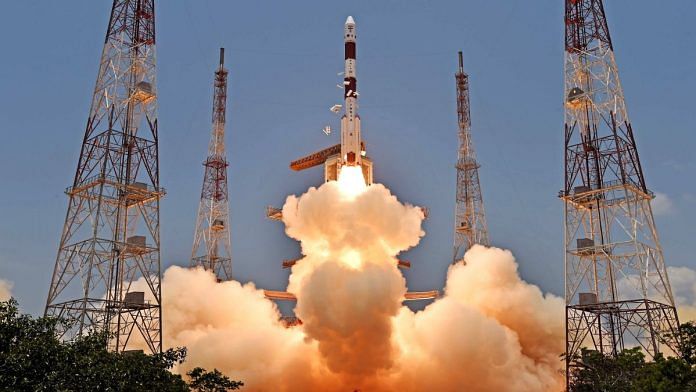New Delhi: After traversing the vacuum of space for 127 days, Aditya-L1 — India’s first space-based solar observatory — arrived at its final destination on 6 January this year. The spacecraft is hovering around a rough region in space between the Sun and the Earth, called L1.
During its voyage as well as the subsequent eight months after reaching the imaginary point, Aditya-L1 achieved the unthinkable, setting countless precedents for future space missions.
“In terms of technological aspects, we learnt how to place a spacecraft around a Lagrange point. In terms of science aspects, Aditya-L1 is meant to observe the Sun in different wavelengths. Aditya-L1 is a multi-wavelength, multi-directional, multi-spatial and multi-instrument observatory,” Professor Anil Bhardwaj, director of Ahmedabad-based Physical Research Laboratory (PRL) told ThePrint. PRL has developed an instrument for the mission.
As India marks one year since the launch of Indian Space Research Organisation’s (ISRO’s) solar mission on 2 September, ThePrint explains Aditya-L1’s milestones so far, its early promising scientific observations and which mysteries of the Sun it plans to unravel over the next few years.
First Indian spacecraft to reach L1
In January, Aditya-L1 became the first Indian spacecraft to reach the Sun-Earth Lagrange Point 1 (L1). Lagrange points are locations in space around which an object tends to stay in a stable orbital configuration because gravitational forces exerted by two large bodies balance the force required by the object to orbit the point.
Located 1.5 million kilometres from the Earth, L1 is a special and vantage location in space because not only does it provide Aditya-L1 with an uninterrupted view of the Sun’s outer atmosphere or corona, but also enables the spacecraft to save fuel and conserve energy.
This is because at this point, the gravitational forces exerted by the Sun and the Earth on Aditya-L1 balance the centripetal force (which keeps a body moving along a curved path and is directed towards the centre of the path) required by the spacecraft to keep moving around the location. As a result, the spacecraft is in an equilibrium state and a stable position, and simply hovers in a halo orbit around L1, without spending much fuel.
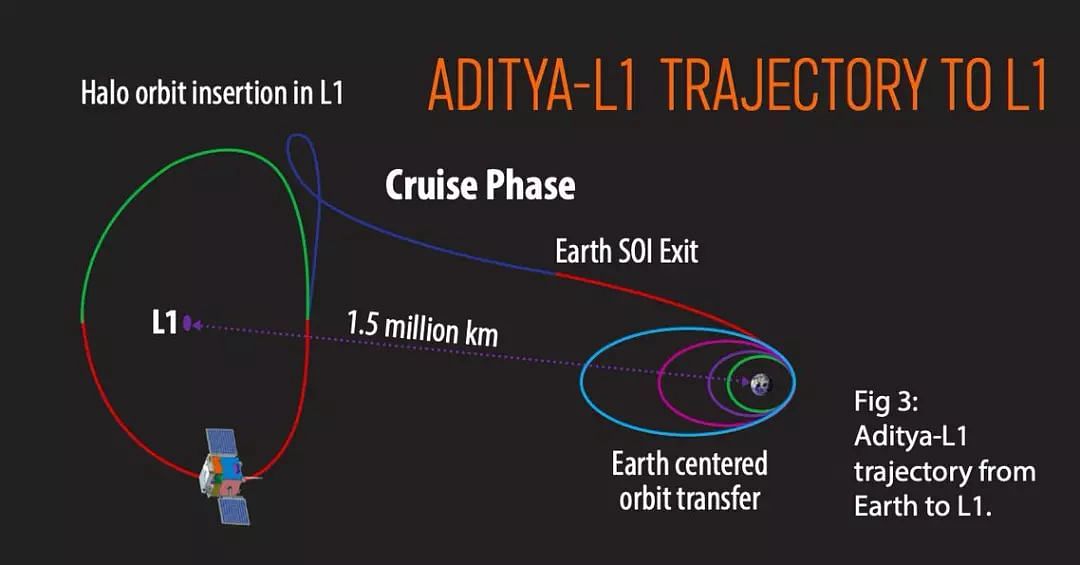
A halo orbit is neither a perfect circle nor an oval, but a lopsided shape known as a lissajous figure — a pattern formed due to the complicated geometry of gravitational interactions there. Each halo orbit takes 178 Earth days.
The strategic point is imaginary and is located on the line joining the Sun and the Earth. The distance between Sun and Earth is 150 million kilometres and that between Aditya-L1 and Earth is 1.5 million kilometres, which implies that the spacecraft is 148.5 million kilometres away from the Sun. This allows it to study the Sun without experiencing the star’s scorching heat.
“The distance between Aditya-L1 and the Earth is four times that between Earth and the Moon. In terms of distance between Sun and Earth, we are just one percent away from Aditya-L1 on the straight line joining Sun and Earth. On the same line, the spacecraft is 99 percent away from the Sun,” Professor Bhardwaj said. “A lot of technological challenges had to be overcome to send Aditya-L1 to the halo orbit around L1 because it is an imaginary point.”
On 19 September 2023, Aditya-L1 performed a manoeuvre called ‘Trans-Lagrangian Point 1 Insertion’, entering the trajectory towards L1.
On 30 September, it exited the Earth’s gravitational sphere of influence, becoming India’s second spacecraft to do so after Mangalyaan-1.
Also Read: UK scientists taught a ‘brain’ made of jelly to play Pong. It aced the video game in 20 mins
Scientific experiments during the journey
Aditya-L1’s objectives are to study the dynamics of the corona, observe the plasma environment around the Sun, measure the temperature, velocity and density of different regions on the corona, identify sequences of solar activities, study space weather drivers, the physics and heating of the corona and chromosphere (layer immediately below the corona), heat differences between different layers, and the initiation and development of coronal mass ejections and flares.
It aims to conduct magnetic field measurements in the corona and understand the interaction of charged particles in solar winds with Earth’s atmosphere and satellites, among other goals. It also intends to understand those processes inside the Sun, which lead to solar flares, coronal mass ejections and geomagnetic storms (major disturbances caused in Earth’s magnetosphere due to exchange of energy between solar winds and space environment surrounding the planet).
The observatory is expected to function for at least five years, and as space records go, it will likely function for much longer than that.
To study the Sun, the spacecraft uses payloads that make simultaneous observations in different wavelengths. Some were switched on while Aditya-L1 was travelling towards L1 after launch.
While travelling towards its destination, Aditya-L1 conducted scientific experiments, such as measuring high-energy particles, capturing its first high-energy X-rays from solar flares, measuring energy variations in protons and alpha particles (positively charged helium ions), and capturing full-disk images of the Sun in near-ultraviolet wavelengths.
It is equipped with seven payloads, four of which are remote sensing instruments (used to detect physical parameters of a particular area by measuring reflected and emitted radiation from a distance), while three are in-situ instruments (used to measure events in their original place).
“The spacecraft’s remote sensing payloads observe the Sun in hard and soft X-rays, ultraviolet and visible wavelengths. The in-situ instruments analyse the plasma coming from the Sun,” Professor Bhardwaj explained.
The remote sensing payloads are Visible Emission Line Coronagraph (VELC), Solar Low Energy X-ray Spectrometer (SoLEXS), Solar Ultraviolet Imaging Telescope (SUIT) and High Energy L1 Orbiting X-ray Spectrometer (HEL1OS). In-situ payloads include Aditya Solar wind Particle Experiment (ASPEX), Plasma Analyser Package for Aditya (PAPA) and Advanced Tri-axial High Resolution Digital Magnetometers.
The VELC, developed by the Indian Institute of Astrophysics (IIA) in Bengaluru, blocks Aditya-L1 from the entire Sun, except the corona. In other words, Aditya-L1 always views the Sun in total solar eclipse mode. This is known as occulting and helps other payloads study what goes on in the outer layers, without interference from the Sun’s bright light.
ASPEX, developed in PRL, is composed of low and high-energy spectrometers, which are used to obtain information about an object by understanding its light properties. Solar Wind Ion Spectrometer (SWIS) is the low-energy and Supra Thermal Energetic Particle Spectrometer (STEPS) is the high-energy spectrometer.
“The ASPEX spectrometers observe the Sun in the ecliptic plane, which refers to the plane in which the Earth goes around the Sun. We also look towards the north and south, and backwards towards the Earth,” Professor Bhardwaj said.
The payloads have been tuned in such a way that they can observe the solar atmosphere and conduct experiments to understand the local environment around L1.
Plasma from the Sun contains charged particles, like protons, and ions of different elements, such as nitrogen, carbon and oxygen. Professor Bhardwaj explained that they constitute a mere one percent of the solar wind.
STEPS, which measures high-energy ions present in solar winds, is Aditya-L1’s first payload to start scientific experiments. On 10 September 2023, it started measuring electrons and suprathermal ions, or highly energetic particles, at distances greater than 50,000 kilometres from the Earth.
ISRO measured the change in the behaviour of the energetic particles with time and with these observations, scientists can analyse how the behaviour of solar wind particles changes in the presence of Earth’s magnetic field.
HEL1OS, a hard X-ray spectrometer, captured its first high-energy X-ray glimpse of solar flares on 7 November 2023. It studies solar flares by measuring hard X-rays, which are high-energy X-rays emitted by the Sun. With data obtained from HEL1OS, researchers can study explosive energy release and electron acceleration during impulsive phases of solar flares. These refer to phases during which electrons and other particles are accelerated after the stored energy in the Sun’s magnetic field is released.
SWIS became operational on 1 December 2023 and began measuring energy variations in protons and alpha particles in solar winds.
On 8 December 2023, SUIT, an ultraviolet telescope, captured full disk images of the Sun in near-ultraviolet wavelengths. It obtained several images of the Sun in wavelengths ranging from 200 to 400 nanometres, a first-of-its-kind feat. By studying these images, scientists can better understand the Sun’s photosphere (visible outer disk) and chromosphere (layer between photosphere and corona).
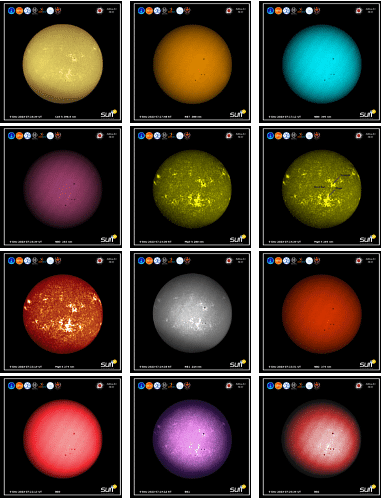
While observational data has been released to the public, scientific papers are yet to be published.
Also Read: ISRO prepares for responsible space missions, aims to go debris-free by 2030
Promising early results
On 11 January, ISRO deployed Aditya-L1’s six-metre-long magnetometer boom (arm). It is equipped with two highly accurate magnetometer sensors, aimed at measuring low-intensity interplanetary magnetic fields in space and the magnetic fields at L1, in order to understand how solar activities affect magnetic fields in the interplanetary medium.
The PAPA payload, whose aim is to understand solar winds, solar wind ions and their composition, analyse particles and energies, and study electrons and heavier ions in solar winds in different directions, has decoded the Sun’s wrath. It is working towards understanding mechanisms behind explosions of magnetic fields and plasma from the Sun’s corona—known as coronal mass ejections— and how they affect solar winds and other phenomena.
Coronal mass ejections cause variations in total electron and ion counts in solar winds with time. PAPA measured these changes from 10 to 11 February.
ISRO then compared PAPA’s data with those of NASA’s Deep Space Climate Observatory (DSCOVR) and Advanced Composition Explorer (ACE) satellite, both of which are located at L1. PAPA’s observations align with those made by the NASA satellites, indicating that Aditya-L1 is effective in monitoring space weather conditions, and can detect and analyse solar phenomena.
The payload studied total counts of solar wind electrons and ions before halo orbit insertion of Aditya-L1, during the insertion and after the process.
“Aditya-L1 can give us warnings of incoming plasma from the Sun about one hour before they reach the Earth. Instruments that are prone to damage from solar plasma can be protected in advance,” Professor Bhardwaj said.
In May, Aditya-L1 captured solar events, such as solar flares, subsequent geomagnetic storms, and images of sunspots and active regions a few days after the storms were over.
“During geomagnetic storms in May, highly charged particles were released from the Sun and analysed by ASPEX,” Professor Bhardwaj told ThePrint.
SUIT’s images of the solar disk in near-ultraviolet wavelengths captured in May showed solar flares and sunspots, which are areas where magnetic fields are 2,500 times stronger than the magnetic field around the Earth. This information is beneficial for space weather predictions to determine how solar flares heat up the chromosphere, how energy is distributed in the layer, and what the overall impact of ultraviolet radiation is on the Sun’s surroundings.
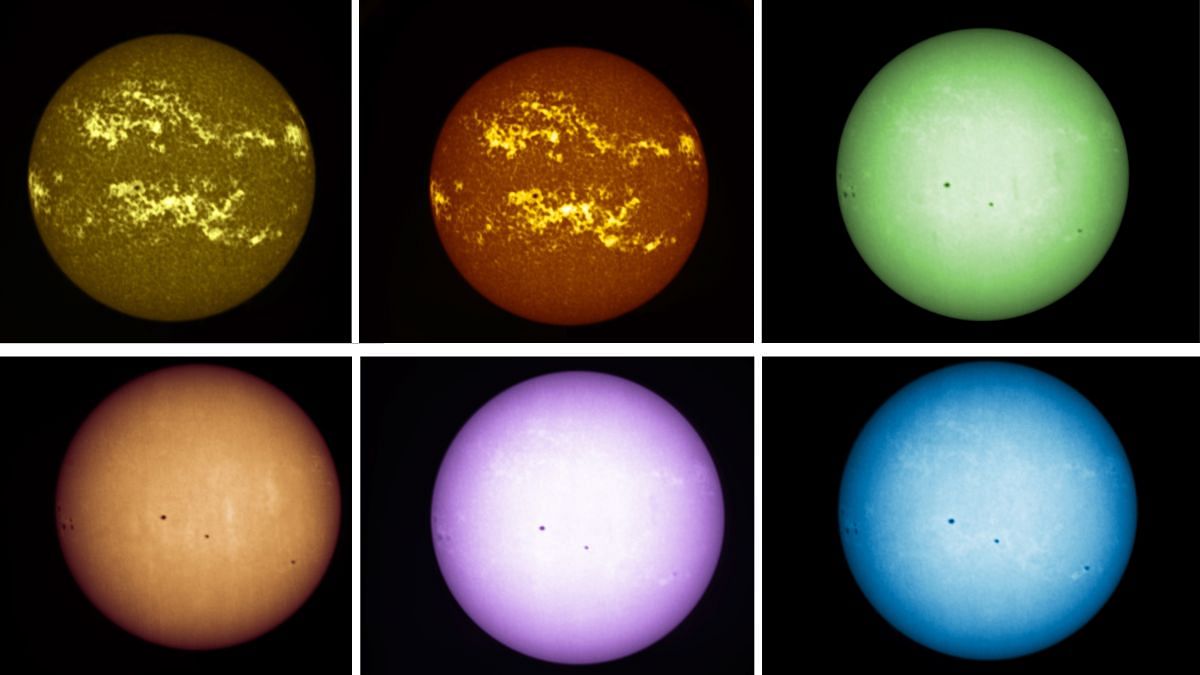
VELC, equipped with a multi-slit spectrograph (instrument dispersing electromagnetic radiation from the Sun into a spectrum), observed the solar corona on 14 May at 530.3 nanometres.
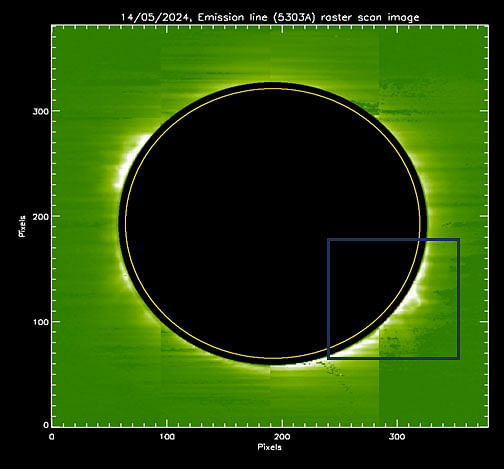
The yellow circle in the VELC image indicates the edge of the photosphere, and the black circle denotes the extent to which the VELC disk has blocked sunlight so that the solar corona can be visible with greater clarity.
During the geomagnetic storms in May, the highly charged particles released from the Sun were also analysed by ASPEX.
“ASPEX’s spectrometers observed huge changes in plasma flux during the May events. These solar storms and flares affected the Earth, especially the polar regions. After interacting with the Earth’s magnetic field lines, the charged particles reached the poles. Aircraft were asked to avoid flying above the poles because passengers would have experienced higher radiation, in addition to communication and navigation issues,” Professor Bhardwaj said. “We are in the solar maximum period, which is why we see so many flares.”
The period of greatest solar activity during the Sun’s 11-year-old cycle is known as solar maximum.
The Solar X-ray Monitor on Chandrayaan-2’s orbiter has observed that a significant number of micro solar flares occur even during the Sun’s quiet period or solar minimum, which is the period of least solar activity during the Sun’s 11-year-old cycle, the PRL director explained. “In one year, around 100 micro solar flares were observed,” he said.
What more can be learnt
On 2 July, Aditya-L1 completed its first halo orbit around L1, taking 178 days—equivalent to around six months.
Aditya-L1 is poised to provide significant information about the dynamics of space weather, solar flares, and propagation of particles and fields in the interplanetary medium, and is expected to help scientists better understand the phenomenon of coronal heating.
Aditya-L1’s findings may help scientists understand the nuclear fusion reactions, which occur inside the 4.5-billion-year-old star, and how they power it. The temperature of the central region of the Sun, or the core, is about 15 million degrees Celsius and that of the photosphere is about 5,500 degrees Celsius. Aditya-L1 will also study the reasons behind this difference in temperature.
“The surface of the Sun has a temperature of about 6,000 Kelvin. The corona’s temperature is one million Kelvin. We want to understand how the temperature rises from 6000 Kelvin to one million Kelvin in the corona,” Professor Bhardwaj said.
It is counterintuitive that the core (the heat source) is inside the Sun, but the temperature increases as one moves away from the surface towards the corona.
“Higher energy wavelengths, such as gamma rays, X-rays and ultraviolet rays get absorbed in the upper atmosphere, producing the ionosphere. But visible wavelengths, some infrared wavelengths and radio wavelengths are received by the Earth, and hence, we are able to probe these from the planet. Since higher energy photons cannot be probed from the surface of the Earth, we chose Aditya-L1 to study the Sun,” he added.
By studying the changing environmental conditions in space, Aditya-L1 has provided insights into how solar activities and charged particles in solar winds impact space weather in real time.
The charged particle environment and the nature of magnetic fields near the Earth change, when particles and magnetic fields from the Sun are directed towards the planet. Since these explosive phenomena can affect space assets, it is essential to send spacecraft that will perform experiments to understand the impact of solar activities on space weather in real time. Aditya-L1 is one such solar mission.
(Edited by Mannat Chugh)



